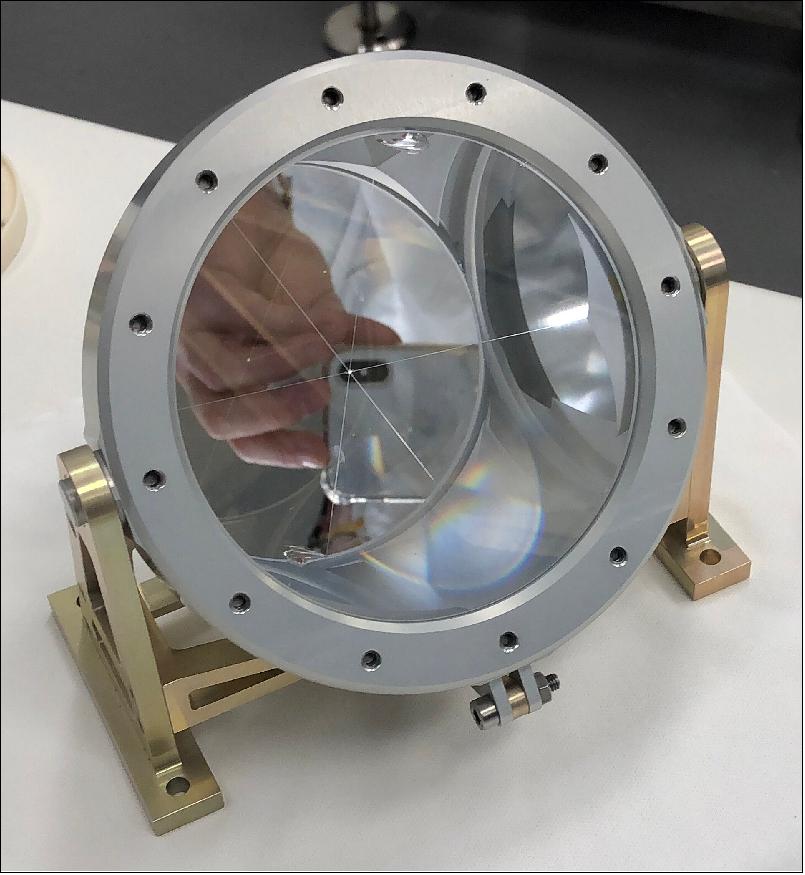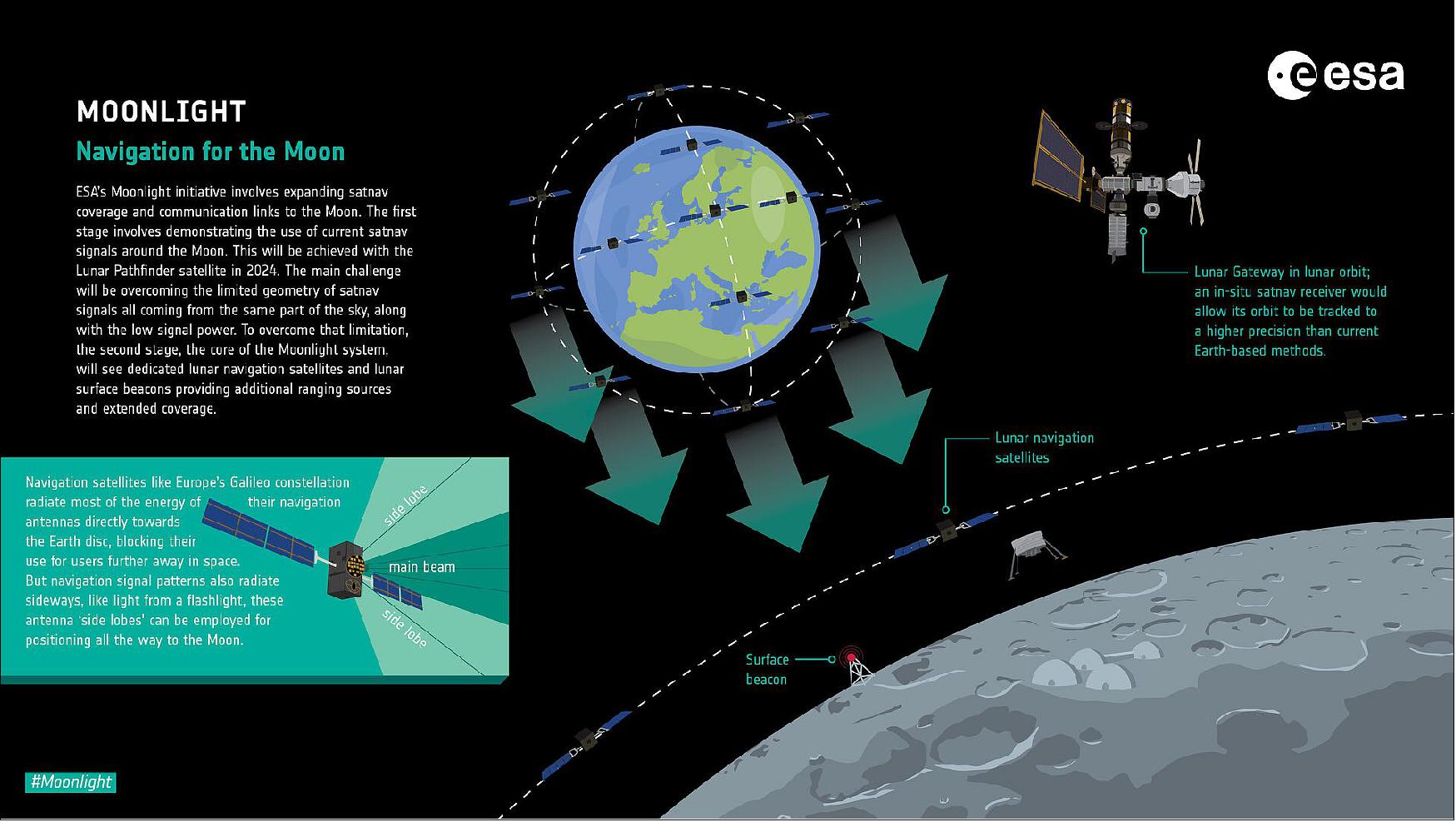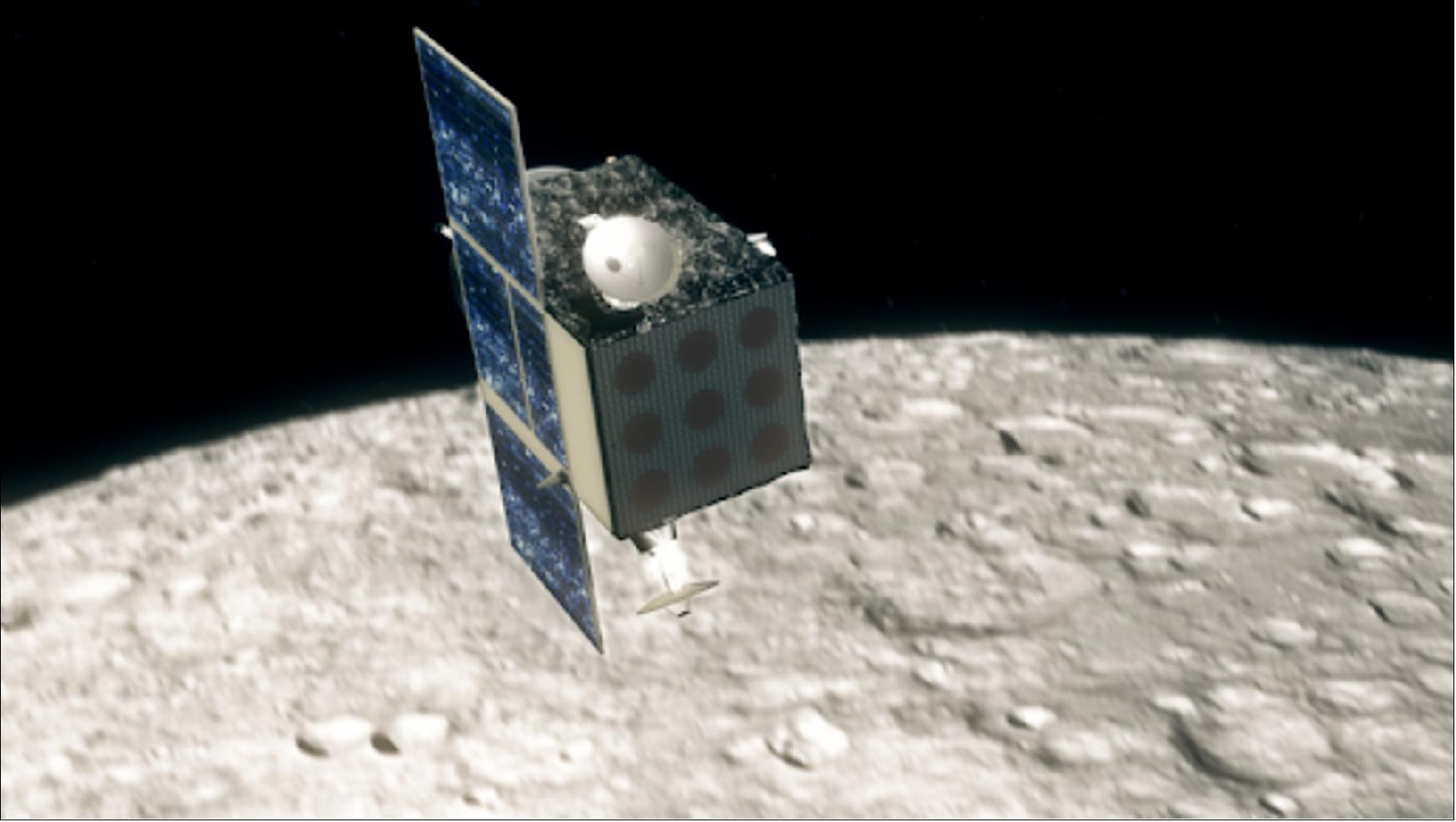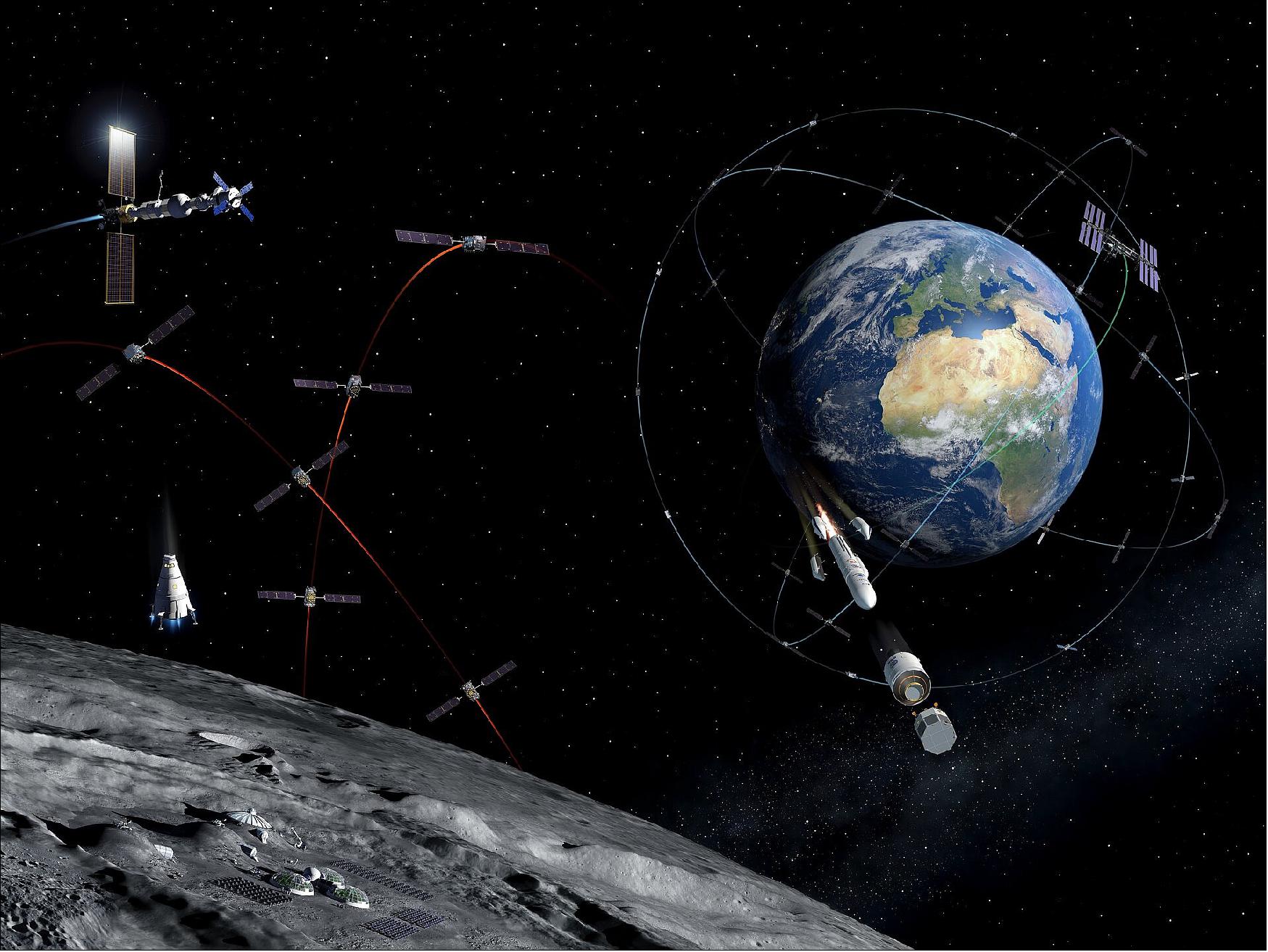MoonLIGHT (Moon Laser Instrumentation for General relativity/geophysics High-accuracy Tests)
Non-EO
ESA
NASA
Quick facts
Overview
| Mission type | Non-EO |
| Agency | ESA, NASA |
MoonLIGHT (Moon Laser Instrumentation for General relativity/geophysics High-accuracy Tests)
Infrastructure and Services Development Status References
MoonLIGHT is a laser retroreflector on the Moon which allows laser beams sent from Earth to be reflected back from the Moon to receivers on our planet. This allows very precise measurement of the distances between the reflector and the ground station. 1)
Known as lunar laser ranging, this technique has been in use since the Apollo missions to investigate Einstein's theory of general relativity, lunar geophysics and the Earth-Moon dynamics, among other fields of study. However, data from retroreflectors of the Apollo era is not as precise due to lunar vibrations, or the perceived lagging and wanning of the Moon when viewed from Earth, caused by its eccentric and tilted orbit of our planet.
The MoonLIGHT retroreflector can reduce this error thanks to its next-generation compact design. The single, larger reflector with a front face 100 mm in diameter can improve accuracy to within millimeters.

Developed by the Italian National Institute of Nuclear Physics (INFN) in Frascati and managed by ESA, MoonLIGHT is part of NASA's Commercial Lunar Payload Services initiative to the Reiner Gamma region of the Moon, which has one of the most distinctive and enigmatic natural features on the Moon, called lunar swirl, characterized by high surface luminosity (albedo) and the very rare presence of a local magnetic field.
Infrastructure and Services of ESA
Lunar exploration relies on the extensive expertise that is on hand across ESA. As a new lunar economy emerges, it will create new opportunities involving robots, habitats and transportation. Missions to the Moon share similar communication and navigation needs that could be satisfied using a constellation of lunar satellites. 2)
Under the agency's "Moonlight" initiative, ESA is exploring with industry the necessary technical solutions along with delivery models for the provision of lunar telecommunication and navigation services.
ESA sees its ground station network "uniquely equipped to support lunar exploration missions due to advanced technology and a global geography". "Ground stations are an important element in the Agency's ambitious lunar exploration goals, supporting ESA, international partners and European industry", it said.


Development Status
• May 3, 2022: Engineers have used ESA's next-generation communications research facility to simulate links between Earth and the Moon via satellites. 4)
- As the world becomes ever more digitalised and connected – between everything and everyone – such connectivity is poised to transform life on Earth and beyond.
- Next-generation 5G and 6G technology will provide fast and high-volume data connectivity to fuel this transformation – and telecommunications satellites will play a crucial role in enabling the seamless and ubiquitous connectivity on which 5G and 6G networks rely.
- Interoperability between terrestrial 5G communications links and telecommunications satellites is crucial to ensure that everything and everyone stays connected wherever they go.
- Engineers recently conducted a series of tests to demonstrate how to switch between 5G terrestrial links and satellites.
- Researchers from the University of Luxembourg's Interdisciplinary Centre for Security, Reliability and Trust (SnT) initially established an end-to-end 5G data communications link between their 5G-SpaceLab and ESA's 5G/6G Hub located at Harwell in the UK.

- In the first test, the engineers connected commercial 5G standard-compliant smartphones to the 5G radio access networks at both ends and verified the terrestrial connection between them.
- Then ESA's end of the connection was rerouted via satellite to demonstrate the interoperability of the terrestrial and satellite systems.
- Finally the university's end of the connection was passed through a lunar communications channel emulator, developed by researchers to mimic the communications delays experienced by a data trunk link between Earth and the Moon. Using the set up, engineers attempted to steer a rover trundling across the lunar surface. The accumulated latency over the terrestrial, satellite and emulated lunar communications infrastructure caused a round-trip delay of three to four seconds between the issuing of the rover instruction and the rover's response.
- Jorge Querol, who coordinates the 5G-SpaceLab at the University of Luxembourg, said: "5G and 6G are playing a key role in the development of future complex communications systems in space. Future lunar activities such as resource exploitation and human settlements will require such communications systems for their safe, reliable and efficient operation. The purpose of connecting both labs was to successfully demonstrate lab federation and technology interoperability. Using the ESA 5G/6G Hub enabled us to combine real-time over-the-satellite transmission to our lunar communications emulation facility."
- Antonio Franchi, Head of ESA's 5G/6G Strategic Programme, said: "5G and 6G technology is predicted to generate staggering benefits for economies worldwide over the next decade, including autonomous vehicles, industrial automation and telehealth. Telecommunications satellites will play a crucial role in enabling the ubiquitous connectivity on which 5G and 6G networks rely. Our demonstration of the seamless switching between a terrestrial network and a space-enabled network shows the great promise of this technology."
- Elodie Viau, Director of Telecommunications and Integrated Applications at ESA, said: "Next-generation communications technologies are crucial to keeping everyone and everything connected at all times. Europe must continue to invest so that ESA can continue to create jobs and prosperity in Europe by fostering innovation that helps European space companies succeed in competitive global markets. At the same time, ESA seeks to enable the sustainable exploration of space by supporting private space firms in Europe to create a network of telecommunication and navigation satellites around the Moon, in a project called Moonlight. This collaboration is just one example of how ESA is shaping the future."
• March 29, 2022: ESA is going to the Moon – in collaboration with its international partners – and seeks to build a lasting lunar link to enable sustainable space exploration. 5)
- The agency has now evaluated initial ideas to create a network of lunar telecommunications and navigation satellites.
- Creating a commercial telecommunications and navigation service for the Moon will allow many of the dozens of planned lunar missions to share the same infrastructure to communicate with Earth, as well as to find their way on the lunar surface.
- The service is needed because the planned missions are becoming regular trips to Earth's natural satellite rather than one-off expeditions.
- Using a shared telecommunications and navigation service will reduce the design complexity and weight of individual missions, making them more cost-efficient.
- Lowering the ticket price to lunar exploration could also empower a wider group of ESA member states to launch their own national lunar missions, inspiring the next generation of scientists and engineers.
- Two consortia of companies have now completed their system concept reviews, which set out how to create the lunar constellation, under ESA's Moonlight initiative to identify the best way to create a lasting link with the Moon.
- The reviews set out the business and technical analysis needed to identify and justify a number of feasible system concepts for creating the lunar network. The next step will be to define a detailed system architecture and identify the most suitable partnership models between private space companies and ESA.
- Telespazio leads the first consortium. The consortium includes: satellite operators Inmarsat and Hispasat; manufacturing companies such as Thales Alenia Space Italy, OHB System in Germany and Canadian space technology company MDA; Italian Aerospace Logistics Technology Engineering Company (ALTEC); small and medium-sized enterprises such as Nanoracks Europe and Argotec; and universities and research centres such as SEE Lab, SDA Bocconi and Politecnico di Milano.
- The second consortium is spearheaded by Surrey Satellite Technology Limited, both in the service prime capacity through its lunar services brand SSTL Lunar and as the satellite manufacturer. The consortium includes: satellite manufacturer Airbus; satellite network providers SES, based in Luxembourg, and Kongsberg Satellite Services, based in Norway; the Goonhilly Earth Station in the UK; and British satellite navigation company GMV-NSL.
- NASA's Artemis programme will use several of ESA's service modules to return humans to the Moon, including the ESPRIT communications module for the lunar Gateway's living quarters for astronauts. With its European industrial partner, ESA is helping to build the Lunar Pathfinder, showcasing lunar communications service provision by providing initial services to early lunar missions, including a complete lunar navigation in-orbit demonstration.
• May 20, 2021: A bold proposal to create a commercially viable constellation of lunar satellites has taken a step closer. 6)
- Two consortia of companies will be supported by ESA to devise detailed definitions of how to provide telecommunications and navigation services for missions to the Moon, under the agency's Moonlight initiative.
- Such a lasting lunar link will enable sustainable space exploration.
- ESA is going to the Moon together with its international partners including NASA.
- Dozens of international, institutional and commercial teams are sending missions to the Moon that envisage a permanent lunar presence. These will become regular trips to Earth's natural satellite rather than one-off expeditions.
- Many of these initiatives come from the main space institutions in China, India, Japan and Russia, alongside other spacefaring nations, as well as private entities across the globe.
- A reliable and dedicated lunar communications and navigation service would allow missions to land wherever they wanted. Radio astronomers could set up observatories on the far side of the Moon. Rovers could trundle over the lunar surface more speedily. It could even enable the teleoperation of rovers and other equipment from Earth.
- Using a shared telecommunications and navigation service would reduce the design complexity of future individual missions and make them lighter, freeing space for more scientific instruments or other cargo, making each individual mission more cost-efficient.
- Lowering the ticket price to lunar exploration could empower a wider group of ESA member states to launch their own national lunar missions. Even on a relatively low budget, an emerging space nation would be able to send a scientific CubeSat mission to the Moon, inspiring the next generation of scientists and engineers.
- Commercial bodies could use innovative technologies developed for the Moon to create new services and products on Earth, which would create new jobs and boost prosperity. They could also identify new Moon-enabled services and products such as virtual reality games in which players manipulate lunar robots or see through the eyes of lunar astronauts.
- ESA is providing several service modules for NASA's Artemis program to return humans to the Moon by 2024, including the ESPRIT communications module for the lunar Gateway's living quarters for astronauts. With its European industrial partner, ESA is helping to build the Lunar Pathfinder, showcasing lunar communications service provision by providing initial services to early lunar missions, including a complete lunar navigation in-orbit demonstration.
- The Moonlight initiative builds on both the ESPRIT (European System Providing Refueling, Infrastructure and Telecommunications) communications module and the Lunar Pathfinder.
• May 20,2021: As international teams across the world forge plans to revisit the Moon, ESA is elaborating how best to facilitate this exploration. 7) 8)
- As part of its Moonlight initiative, the agency is encouraging European space companies to put a constellation of telecommunications and navigation satellites around the Moon.
- To succeed, the proposed lunar missions will require reliable navigation and telecommunication capabilities. Building these independently would be costly, complex and inefficient.
- If this work were outsourced to a consortium of space companies, each individual mission would become more cost-efficient.
- Having one system dedicated to lunar telecommunications and navigation could reduce design complexity, liberating missions to concentrate on their core activities.
- Because missions could rely on this dedicated telecommunications and navigation service, they would be lighter. This would make space for more scientific instruments or other cargo.
- An accurate and reliable telecommunications and navigation service would enable missions to land wherever they wanted. Radio astronomers could set up observatories on the far side of the Moon.
- Rovers could trundle over the lunar surface more speedily. It could even enable the teleoperation of rovers and other equipment from Earth.
- Finally, lowering the ticket price to lunar exploration could empower a wider group of ESA member states to launch their own national lunar missions. Even on a relatively low budget, an emerging space nation would be able to send a scientific CubeSat mission to the Moon, inspiring the next generation of scientists and engineers.
• May 17, 2021: Dozens of international, institutional and commercial teams are planning to send missions to the Moon, envisaging a permanent human lunar presence. Using a shared telecommunications and navigation service would reduce the design complexity of future individual missions and make them lighter, freeing space for more scientific instruments or other cargo, making each individual mission more cost-efficient. 9)
- A lasting lunar link will enable sustainable space exploration.
- Two consortia of companies will be supported by ESA to devise detailed definitions of how to provide telecommunications and navigation services for missions to the Moon, under the agency's Moonlight initiative.
- SSTL (Surrey Satellite Technology Ltd) will lead the first consortium, both in the service prime capacity through its lunar services brand SSTL Lunar and as the satellite manufacturer. The consortium also includes: satellite manufacturer Airbus; satellite network providers SES, based in Luxembourg, and Kongsberg Satellite Services, based in Norway; the Goonhilly Earth Station in the UK; and British satellite navigation company GMV-NSL.
- The other consortium will be spearheaded by Telespazio (a joint venture between Leonardo 67% and Thales 33%), working with: satellite manufacturer Thales Alenia Space (a joint venture between Thales 67% and Leonardo 33%); satellite operator Inmarsat, based in the UK; Canadian space technology company MDA; Telespazio Germany and the satellite manufacturer OHB Systems in Germany; Spanish satellite operator Hispasat; and the Italian Aerospace Logistics Technology Engineering Company (ALTEC), aerospace engineering company Argotec, Nanoracks Europe, the Politecnico Milano and the Università commerciale Luigi Bocconi.
- The contracts were signed on behalf of ESA by Elodie Viau, Director of Telecommunications and Integrated Applications, in the presence of David Parker, ESA's Director of Human and Robotic Exploration, and Paul Verhoef, ESA's Director of Navigation.
- Elodie Viau said: "A lasting link with the Moon enables sustainable space exploration for all our international partners, including commercial space companies. By using an ESA-backed telecommunications and navigation service for the Moon, explorers will be able to navigate smoothly and to relay to Earth all the knowledge gained from these lunar missions.
- "A robust, reliable and efficient telecommunications and navigation system will make the dozens of individual missions planned for the Moon more cost-efficient and enable smaller countries to become space-faring nations, inspiring the next generation of scientists and engineers."
• March 18, 2021: ESA's Lunar Pathfinder mission to the Moon will carry an advanced satellite navigation receiver, in order to perform the first ever satnav positioning fix in lunar orbit. This experimental payload marks a preliminary step in an ambitious ESA plan to expand reliable satnav coverage – as well as communication links – to explorers around and ultimately on the Moon during this decade. 10)
- Due for launch by the end of 2023 into lunar orbit, the public-private Lunar Pathfinder comsat will offer commercial data relay services to lunar missions – while also stretching the operational limits of satnav signals.
- Navigation satellites like Europe's Galileo constellation are intended to deliver positioning, navigation and timing services to our planet, so most of the energy of their navigation antennas radiates directly towards the Earth disc, blocking its use for users further away in space.

- "But this is not the whole story," explains Javier Ventura-Traveset, leading ESA's Galileo Navigation Science Office and coordinating ESA lunar navigation activities. "Navigation signal patterns also radiate sideways, like light from a flashlight, and past testing shows these antenna ‘side lobes' can be employed for positioning, provided adequate receivers are implemented."
- Just like people or cars on the ground, satellites in low-Earth orbit rely heavily on satnav signals to determine their orbital position, and since ESA proved higher-orbit positioning was possible, a growing number of satellites in geostationary orbit today employ satnav receivers.
- But geostationary orbit is 35,786 km up, while the Moon is more than ten times further away, at an average distance of 384,000 km. In 2019 however, NASA's Magnetospheric Multiscale Mission acquired GPS signals to perform a fix and determine its orbit from 187,166 km away, close to halfway the Earth-Moon distance.

- Javier adds: "This successful experimental evidence provides us high confidence since the receiver we will embark on Lunar Pathfinder will have a significantly improved sensitivity, employ both Galileo and GPS signals and will also feature a high-gain satnav antenna."
- This high sensitivity receiver's main antenna was developed through ESA's General Support Technology Programme, with the receiver's main unit developed through ESA's Navigation Innovation and Support Programme (NAVISP).
- The receiver project is led by ESA navigation engineer Pietro Giordano: "The high sensitivity receiver will be able to detect very faint signals, millions of times weaker than the ones received on Earth. The use of advanced on-board orbital filters will allow to achieve unprecedented orbit determination accuracy on an autonomous basis."
- Lunar Pathfinder's receiver is projected to achieve positioning accuracy of around 100 m – more accurate than traditional ground tracking.

- The availability of satnav will allow the performance of ‘Precise Orbit Determination' for lunar satellites, notes Werner Enderle, Head of ESA's Navigation Support Office: "Traditional orbit determination for lunar orbiting satellites is performed by radio ranging, using deep space ground stations. This Lunar Pathfinder demonstration will be a major milestone in lunar navigation, changing the entire approach. It will not only increase spacecraft autonomy and sharpen the accuracy of results, it will also help to reduce operational costs."
- While lunar orbits are often unstable, with low-orbiting satellites drawn off course by the lumpy mass concentrations or ‘mascons' making up the Moon , Lunar Pathfinder is planned to adopt a highly-stable ‘frozen' elliptical orbit, focused on the lunar south pole – a leading target for future expeditions.
- Earth – and its satnav constellations – should remain in view of Lunar Pathfinder for the majority of testing. The main challenge will be overcoming the limited geometry of satnav signals all coming from the same part of the sky, along with the low signal power.

- Lunar Pathfinder's demonstration that terrestrial satnav signals can be employed to navigate in lunar orbits will be an important early step in ESA's Moonlight initiative. Supported through three ESA Directorates, Moonlight will go on to establish a Lunar Communication and Navigation Service.
- "Over this coming decade, ESA aims to contribute to building up a common communications and navigation infrastructure for all lunar missions based on dedicated lunar satellites," explains Bernhard Hufenbach, managing commercialisation and innovation initiatives for space exploration at ESA.
- "Moonlight will allow to support missions that cannot use Earth satnav signals, such as landers on the far side and is planning to cover the current gap towards the needs expressed by the Global Exploration community, targeting positioning accuracy below 50 metres."

- As well as facilitating lunar exploration, these satnav signals might one day become a tool for science in their own right, used, for example, to perform reflectometry across the lunar surface; sounding the scant dusty ‘exosphere' that surrounds the Moon or by providing a common time reference signal across the Moon, to be used for fundamental physics or astronomy experiments.
- So as well as marking a first in the history of satellite navigation, Javier notes that Lunar Pathfinder's satnav experiment will have larger consequences: "This will become the first ever demonstration of GPS and Galileo reception in lunar orbit, opening the door to a complete way to navigate spacecraft in deep space, enabling human exploration of the Moon."
References
1) "Mirror, mirror, on the Moon," ESA Science & Exploration, 8 December 2021, URL: https://www.esa.int/ESA_Multimedia/Images/2021/12/Mirror_mirror_on_the_Moon
2) "Moonlight: connecting Earth with the Moon," ESA, 16 November 2020, URL: http://www.esa.int/ESA_Multimedia/Videos/2020/11/Moonlight_connecting_Earth_with_the_Moon
3) "Infographic: Moonlight - Navigation for the Moon," ESA Agency, 20 May 2021, URL: https://www.esa.int/ESA_Multimedia/Images/2021/05/Infographic_Moonlight_-_Navigation_for_the_Moon
4) "ESA's 5G/6G Hub used to simulate lunar connection," ESA Applications, 03 May 2022, URL: https://www.esa.int/Applications/Telecommunications_Integrated_Applications/ESA_s_5G_6G_Hub_used_to_simulate_lunar_connection
5) "Satellites around the Moon come another step closer," ESA Applications, 29 March 2022, URL: https://www.esa.int/Applications/Telecommunications_Integrated_Applications/Satellites_around_the_Moon_come_another_step_closer
6) "ESA advances its plan for satellites around the Moon," ESA- Agency, 20 May 2021, URL: https://www.esa.int/About_Us/Corporate_news/ESA_advances_its_plan_for_satellites_around_the_Moon
7) "Moonlight: bringing connectivity to the Moon," ESA Applications, 20 May 2021, URL: https://www.esa.int/ESA_Multimedia/Videos/2021/05/Moonlight_bringing_connectivity_to_the_Moon
8) "SSTL Lunar to Lead Consortium for ESA Moonlight," SSTL Press Release, 20 May 2021, URL: https://www.sstl.co.uk/media-hub/latest-news/2021/sstl-lunar-to-lead-consortium-for-esa-moonlight
9) "Nº 15–2021: Call for media : ESA advances its plan for satellites around the Moon," ESA Applications, 17 May 2021 Press Release, URL: https://www.esa.int/Newsroom/Press_Releases/Call_for_media_ESA_advances_its_plan_for_satellites_around_the_Moon
10) "Galileo will help Lunar Pathfinder navigate around Moon," ESA Applications, 18 March 2021, URL: https://www.esa.int/Applications/Navigation/Galileo_will_help_Lunar_Pathfinder_navigate_around_Moon
The information compiled and edited in this article was provided by Herbert J. Kramer from his documentation of: "Observation of the Earth and Its Environment: Survey of Missions and Sensors" (Springer Verlag) as well as many other sources after the publication of the 4th edition in 2002.
Infrastructure and Services Development Status References Back to top